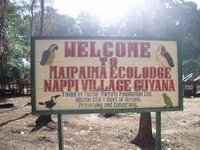
This Amerindian (Makushi Indians) village has about 800 residents, situated on the foot of Kanaku Mountains. The village singed a contract to conserve the natural habitat of wildlife, and instead they were provided with a fund to build the eco lodge. This way, they can generate some income without opting out for lumbering or mining, which destroy the environment. It is owned and operated by the village, and is a same principle as the Iwokrama resort.
Since it opened a couple of weeks ago, Petra and I were the third set of guests. During four days of our stay there we were the only guests, and it was just so special. They cleared up a small area in the middle of jungle and built a few quarters. It has a real secluded feeling to it. We could hear ridiculously amazing sounds of birds as if they were playing one of those silly rainforest sounds relaxation CDs.
The first day after delicious lunch and a nap in a hummock, we ventured out in the jungle to see wild monkeys. We had a guide who is equipped with a knife, a bow and arrows just in case of encountering a jaguar. He was so knowledgeable about the forest and explained some medicinal plants and trees. He showed us the tree that can heal wounds and other sort of a local version of Viagra (!)
We saw a few groups of spider monkeys hanging off the trees. They were starting to get annoyed with our presence and were breaking branches and dropping them. Some little ones were on the back on adult monkeys.
We were able to talk a lot with staff members. They told us some legends like a guy who used to kill people hiding in bamboos and Shaman who can communicate with monkeys. The most amazing story is about tiny forest people (half our size). They are called “Tai Tai” in Makushi language. The guide boy has seen one once, but none has been successful in photographing them. With Anthropological training, I was so fascinated by these stories. I even thought about pursuing PhD and doing research in a village like this, and how wonderful this would be!
I always wanted to try to sleep in a hummock, and this was my last chance to try it. The staff put a mosquito net on the hummock which is hanging on the balcony just in front of our bedroom. I was bit scared after hearing all the stories of jaguars and the forest people, but after all I slept OK. The tip is to lie diagonally in the hummock so that your back is not bent too much. On the second night Petra joined me, but the third night we had to give it up because it was raining.
To be continued…..
このアメリインディアン(マクシ族)の村は人口約800人、カナク山脈の麓に位置している。野生動物の生息地を保護するという約束もとにこのエコロッジを建てる資金を提供された。これで環境を破壊する木の伐採や鉱脈に頼ることなしに現金収入が得れるからだ。村の住民がオーナーであり彼らが運営している。地域の住民参加型森林保護は前述のイオクラマと同じである。
数週間前にオープンしたてなので私とぺトラは3組目の宿泊客。4日間の滞在中私達だけだったので、特別だった。ジャングルの中を開拓して今のところ3つの建物が立っている。文明から隔離され自然のままという感じだった。よくあるジャングルの音を録音したリラックス用のCDでもかけているんじゃないかと思うほどエキゾチックな鳥の鳴き声が聞こえてくる。
初日はお昼のご馳走を頂いた後、ハンモックで少し昼寝してジャングルへ野生の猿を見る為に探検に行った。ガイドの男の子は万が一ジャガーに遭遇した時の為にもナイフと弓矢を持って来ていた。彼は森のことにとても詳しく、薬草など説明してくれた。傷を治す木や地元版バイアグラ(?!)などを見せてくれた。
木からぶら下がっている蜘蛛猿のグループをいくつか見ることができた。猿たちは私達が近づいてくるのが気に食わないようで怒って木の枝を折って下に落としたりしていた。背中に乗った赤ちゃん猿も見られた。
私とぺトラは宿泊客が他にいなかったこともありスタッフの人達とよく話した。竹薮に隠れて人を殺していた男の話や猿にメッセージを送れるシャーマンの話など。一番興味深かったのは森に住む背の小さい部族の話。彼らは普通の人の半分の背丈でマクシインディアンの言葉でタイタイと呼ばれている。ガイドの男の子は一度だけ出くわしたことがあるらしいが、まだ誰も写真を撮ることに成功していないとのこと。文化人類学専攻の私にとっては好奇心がそそられる話ばかりだった。博士課程に進んでこんな村でフィールド研究をできたら素敵だなーとか思わず考えてしまった。
一度ハンモックで寝てみたいなと思っていて、今回が最後のチャンスだった。従業員の人が私達の部屋の前のバルコニーに釣り下がっているハンモックに蚊帳を付けてくれた。ジャガーや森の部族のことを考えたら少し怖くなったがなんとか眠れた。コツはハンモックに斜めに横になることらしい。こうするとなるべくひらべったく寝られる。2日目の夜はぺトラも加わり3日目だけ雨が降っていたので諦めた。
また続く...
Aucun commentaire:
Enregistrer un commentaire
Please leave a comment! コメントを残して頂けると嬉しいです。
Anonymous Usersをクリックするとコメントが残せます。